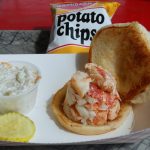Connecticut Drive: Litchfield County
By Carol Cambo Get map of this trip. Yankee‘s driving tour of Litchfield County in the northwest corner of Connecticut follows a 56-mile tour in a counter-clockwise direction, beginning in the town of Litchfield and a visit to nearby Goshen to meet the animals of Action Wildlife.Get Our FREE Yankee Food Award Gift Guide! Email(Required) […]

Coffee By Design | Portland, Maine
Photo Credit : Katherine KeenanBy Carol Cambo
Yankee‘s driving tour of Litchfield County in the northwest corner of Connecticut follows a 56-mile tour in a counter-clockwise direction, beginning in the town of Litchfield and a visit to nearby Goshen to meet the animals of Action Wildlife.
Boitano the poitou donkey was playing hard to get. Jim Mazzarrelli, owner of Action Wildlife in Goshen, Connecticut, told us an offering of fresh grass would coax his distinctive whinny. My friend waved greenery in front of Boitano’s snout, rewarded only by indifferent silence.
We fared better, noise-wise, in the rare-animal farm’s petting barn, where children shrieked as their hands were snuffled by bleating baby goats. And later, as we walked around the vast property, zebus and oryx, llamas and ostriches — 300 animals in all — greeted us from their spacious pens with snorts and grunts.
This was our first stop on a tour of Litchfield County. Action Wildlife surprised us because these lush hills have earned much of their mystique from being home to the likes of Mia Farrow, Meryl Streep, Dustin Hoffman, and other Hollywood emigres — not Persian red sheep and fainting goats.
From the farm, the road west to the Cornwalls (Route 4) is bounded by pastures rimmed with stone walls. There are walls of shale and fieldstone, stacks of massive granite boulders, and still other walls made from stones that look polished as if plucked from a riverbed.
From Route 4, follow Route 128. The road will dip sharply into the village of West Cornwall. At its heart is a prime photo opportunity: an 1864 red covered bridge spans the Housatonic River. Most days you can see fly-fishermen along the riverbanks, filament flashing in the sun as they tempt the trout.
You can’t (and shouldn’t) miss the rustic Wandering Moose Café right next to the bridge, where alfresco diners can listen to the Housatonic hurrying south. Choose from standard deli fare for breakfast and lunch, plus creative salads. The dinner menu is fancier, featuring gourmet pizza, duck, and, fittingly, trout.
Don’t overindulge, because next you must hike uphill to The Wish House, a gift shop/gallery filled with stylish women’s clothing, kitchen accessories, children’s gifts, artwork, and imported items. A few houses away, a former Masonic Hall houses a 45,000-volume collection of rare books and is open on Saturdays to browsers. Notable categories here include literature, diaries, letters, and children’s books.
Also on Main Street is the Cornwall Bridge Pottery store, but if you’re heading south on Route 7, stop at the outfit’s workshop (in Cornwall Bridge), where you can shop for bargain seconds and often catch potters in action.
To get there from here, you’ve got to cross the one-lane West Cornwall Bridge. Observe the local courtesy: Flash your lights to signal drivers on the opposite side to cross. Once over, stay left on Route 7 south, a scenic beauty that passes by Kent Falls State Park, home to the highest multidrop waterfall (some 250 feet) in the state. (A short walk from the parking lot will bring you to the bottom of the falls.)
Continue south on Route 7 toward Kent, keeping your eyes peeled for Sculpturedale and The Dog Show on the left. The outdoor gallery features metal figures by sculptor Denis Curtiss, while his wife’s barn shop carries canine-themed gifts. This stretch of road is fringed with (more) stone walls and pastures, as well as views of the Taconic mountain range to the west. The Appalachian Trail roughly follows this spine as it crosses the northwest corner of Connecticut.
A few miles farther south, the yellow sign at a railroad crossing signals The Sloane-Stanley Museum. Landscape painter Eric Sloane teamed up with Stanley Works and the state of Connecticut to open it in 1969, commemorating the tool company’s 125th anniversary. The museum features Sloane’s collection of early American tools, a re-creation of the artist’s studio, and a pioneer cabin Sloane built in 1974.
As you view Sloane’s works, you’ll notice how he captured the mood of the countryside you’ve been driving through; he had a fascination with barns, and some of the ones he painted still stand in the area.
Down a slope from the museum stands a handsome stone chimney, the remains of the Kent Iron Furnace, one of numerous iron-ore furnaces that operated in the region in the 1800s, turning out pig iron for locomotives and fine machinery. Fittingly, the museum shares a driveway with the Connecticut Antique Machinery Association, a compound of buildings where early tractors, engines, and mining- and farm-related implements are on display.
The sooty skies of yore are far removed from modern-day Kent. This outpost of civilized life offers clear mountain air, gourmet dining, tasteful shops, and fine arts galleries. It’s a magnet for New York City weekenders (it’s about a two-hour drive away), and also a crossroads for Appalachian Trail thru-hikers. There aren’t too many towns with fewer than 3,000 residents in which you can buy gourmet ice cream for a few bucks a cone (at Scoops), Belgian chocolate truffles by the pound (at Belgique), or waist-high, solid-bronze asparagus stalks for $6,000 (at Morrison Sculpture Gallery).
As afternoon lengthened, we remembered our dinner reservations at The Hopkins Inn in New Preston and our plan to take a circuitous route to see one more covered bridge. Schaghticoke Road, just past the Kent School, hugs the west bank of the Housatonic. When it meets back up with Route 7, it crosses Bull’s Bridge, a rustic covered span just below a hydro plant. Beneath, torrents of white water charge over smooth granite.
We took Route 7 back north and turned east on Route 341, then headed down to Lake Waramaug. We took our sweet time on West Shore Road, admiring the gracious old homes. A short hop from the southern tip of the five-mile-long loch, the village of New Preston has a handful of upscale shops where sawmills and forges once made use of the zippy East Aspetuck River, which flows parallel to the main street. Poke around the Village Barn & Gallery for antiques for every budget (lamps a specialty) as well as local info (owner Craig Nelson told us one gated estate we noticed belonged to Joan Rivers).
When we arrived at The Hopkins Inn, the stone terrace overlooking Lake Waramaug beckoned. The scent of grapes ripening (part of Hopkins Vineyard is right behind the inn) was carried on the late-summer breeze. By the time we finished our escargots, wiener schnitzel, and pork tenderloin in a calvados sauce, we were relaxed to the core, washed clean by the rocky, riverine landscape.








I am looking for driving instructions from NO.Kingstown,RI.
THank you–JWR186@cox.net
I can send you a mapquest to Litchfield center. What’s the closest state route near your home?